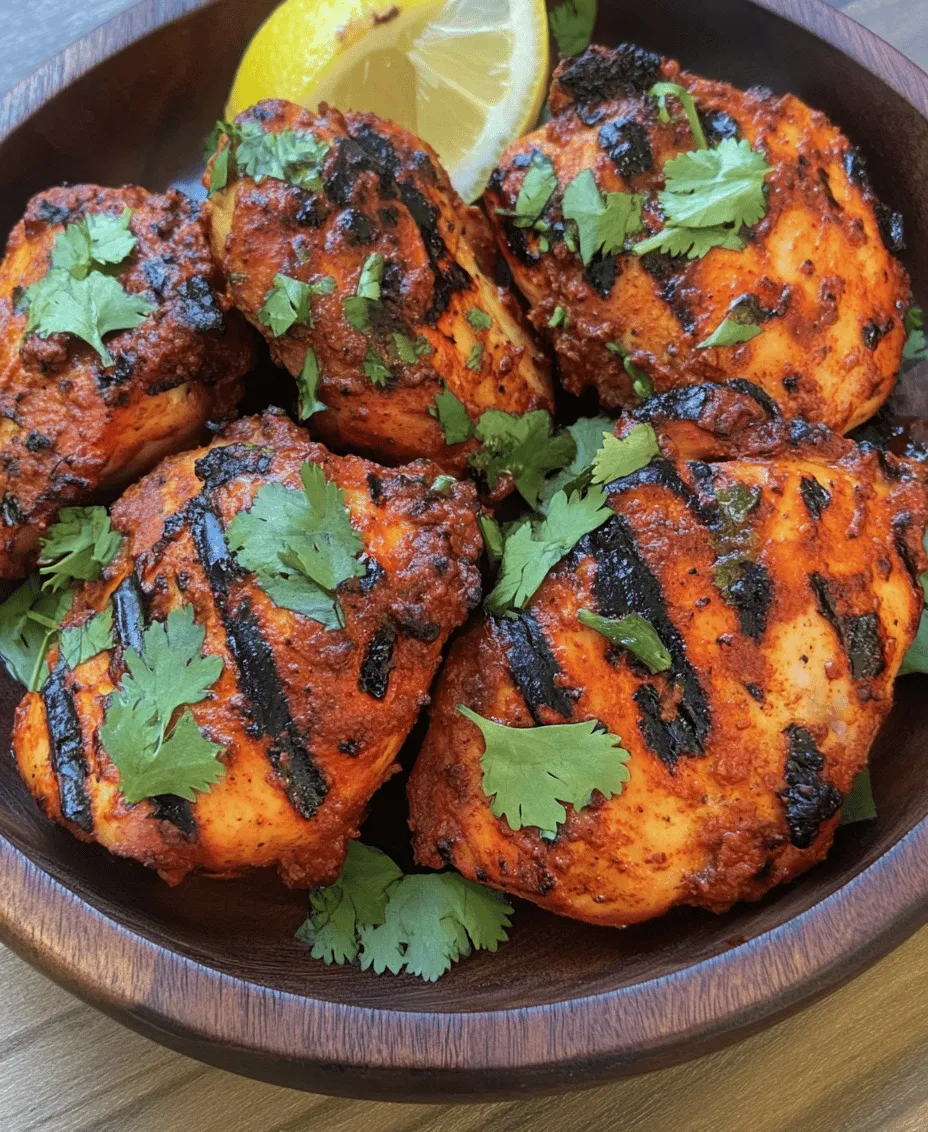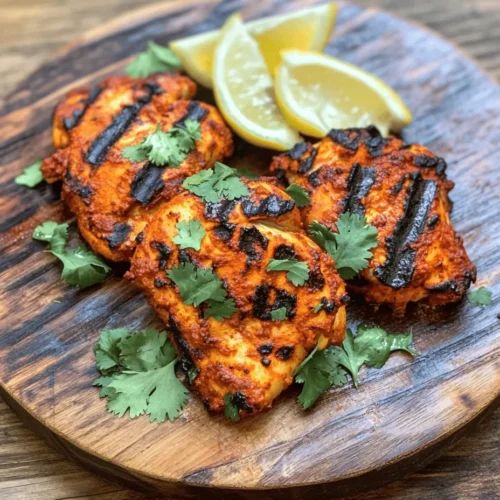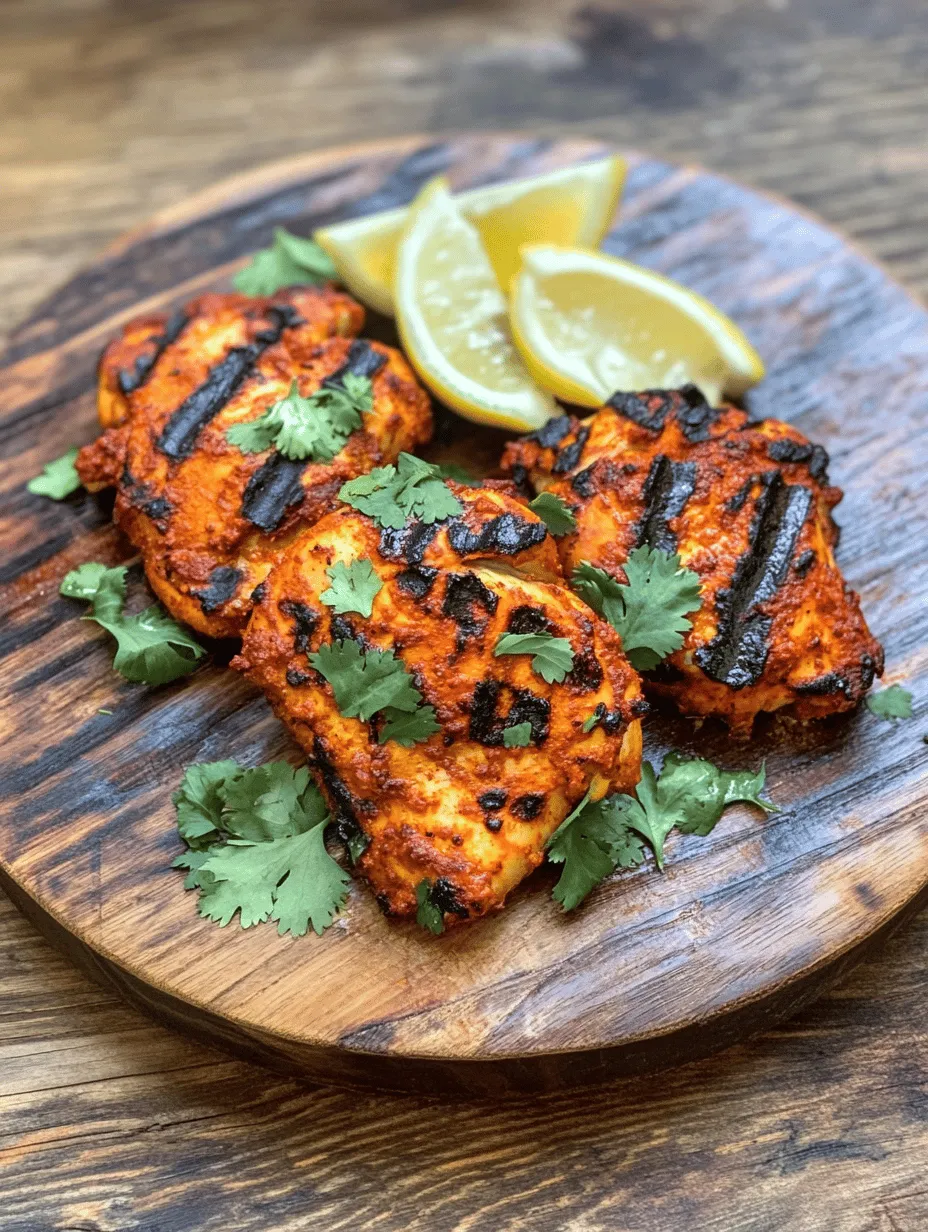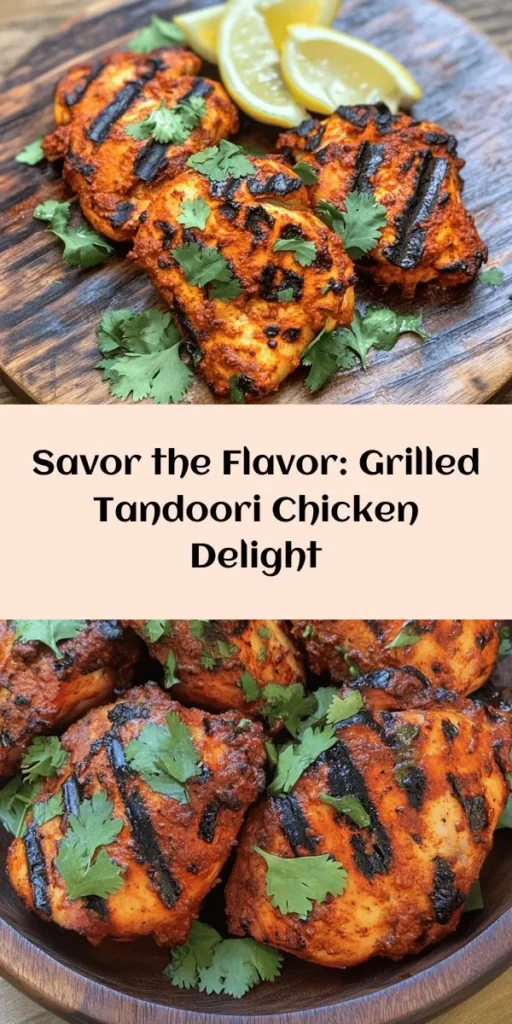Introduction
Tandoori chicken is a culinary gem hailing from the vibrant kitchens of India. This dish is not only loved for its bold, aromatic flavors but also for its rich cultural heritage. Traditionally cooked in a tandoor, a clay oven that reaches high temperatures, Tandoori chicken is marinated in a blend of spices and yogurt, resulting in tender, juicy meat with a distinctive charred exterior. The process of marination is crucial as it not only enhances the flavor of the chicken but also ensures that it remains succulent during cooking.
One of the key ingredients in traditional Tandoori chicken is Greek yogurt, which plays a vital role in the marination process. Greek yogurt is thicker and creamier than regular yogurt, which helps to coat the chicken effectively, allowing the spices to penetrate deeply. Additionally, the lactic acid in yogurt acts as a natural tenderizer, breaking down the proteins in the chicken and resulting in a melt-in-your-mouth texture. Beyond flavor, Greek yogurt also offers numerous health benefits, including probiotics that promote gut health, and being lower in sugar compared to other marinades.
In this article, we aim to guide you through a simple yet authentic grilled Tandoori chicken recipe that you can easily prepare at home. Whether you’re hosting a summer barbecue or looking for a flavorful weeknight dinner, this dish is sure to impress your family and friends.
Understanding Tandoori Chicken
The Tandoori Cooking Method and Its Origins
The cooking method known as “tandoori” dates back thousands of years and has its roots in the Indian subcontinent. Originating from the Punjab region, Tandoori cooking involves marinating meats in a mixture of spices, yogurt, and sometimes lemon juice, before cooking them at high temperatures in a tandoor. The combination of intense heat and smoke from the burning wood or charcoal gives the food a unique flavor and texture that is hard to replicate with other cooking methods.
While traditional Tandoori chicken is cooked in a tandoor, grilling is a popular alternative that many home cooks opt for. Grilling allows for a similar charred effect and smoky flavor, making it a suitable method for those who may not have access to a tandoor. Despite the differences in cooking equipment, the core principles of marination and the spice blend remain the same, ensuring that the essence of Tandoori chicken is captured.
Differences Between Traditional Tandoori Cooking and Grilling
The primary difference between traditional Tandoori cooking and grilling lies in the cooking environment. In a tandoor, the chicken is suspended vertically, allowing the heat to circulate evenly, which results in a distinctive smoky flavor that is hard to achieve on a grill. Additionally, the high temperature of the tandoor creates a searing effect that locks in moisture while forming a beautifully charred exterior.
When grilling, the chicken is typically placed directly over the heat source, which can lead to different results in terms of texture and flavor. However, with the right techniques, grilling can still produce delicious Tandoori chicken with a satisfying crust and juicy interior. The key is to monitor the heat closely and use indirect grilling methods to prevent charring while ensuring that the chicken cooks evenly.
Common Spices Used in Tandoori Recipes and Their Health Benefits
The flavor profile of Tandoori chicken is achieved through a harmonious blend of spices, each of which contributes its unique taste and health benefits. Here are some of the common spices used in Tandoori recipes:
– Cumin: Known for its warm, earthy flavor, cumin is rich in antioxidants and has anti-inflammatory properties. It aids digestion and may help in controlling blood sugar levels.
– Coriander: With its citrusy notes, coriander not only enhances flavor but also boasts antibacterial properties. It is a good source of dietary fiber and helps in detoxifying the body.
– Turmeric: This vibrant yellow spice is famous for its anti-inflammatory and antioxidant properties, thanks to its active compound, curcumin. Turmeric is known to support joint health and improve digestion.
– Garam Masala: A blend of various spices, garam masala adds warmth and depth to the dish. Depending on the mix, it can contain spices like cardamom, cloves, and nutmeg, all of which have their health benefits, including promoting heart health and boosting immunity.
– Cayenne Pepper: This spice adds heat to the dish and contains capsaicin, which has been shown to boost metabolism and promote fat burning. It also has pain-relieving properties.
In addition to spices, fresh ingredients like garlic, ginger, and lemon juice are essential for achieving an authentic flavor. Garlic and ginger not only provide a pungent kick but also have numerous health benefits, including anti-inflammatory effects and improved immune function. Lemon juice adds a zesty brightness and enhances the overall flavor while also helping to tenderize the chicken.
Ingredients Breakdown
To prepare a delicious grilled Tandoori chicken, it’s essential to understand the role of each ingredient in the recipe. Below is a detailed description of the ingredients you will need:
Chicken Thighs
When it comes to choosing the right cut of chicken for Tandoori, bone-in and skinless chicken thighs are highly recommended. This cut of meat is more flavorful and juicier compared to chicken breasts, making it ideal for marination and grilling. The bones also help retain moisture during cooking, ensuring that the chicken remains tender and succulent.
Greek Yogurt
Greek yogurt is a key ingredient in Tandoori chicken marinade. Its thick consistency allows it to cling to the chicken, forming a flavorful coating that penetrates deeply. In addition to flavor, Greek yogurt serves as a tenderizer, thanks to its acidic properties, which break down the proteins in the meat, resulting in a juicy and tender chicken. Furthermore, Greek yogurt adds a creamy texture to the marinade, balancing the spices and enhancing the overall taste.
Spices
– Cumin: Adds warmth and depth to the marinade.
– Coriander: Offers a citrusy flavor and enhances the overall taste profile.
– Turmeric: Provides a beautiful golden color and contributes anti-inflammatory properties.
– Garam Masala: A fragrant blend of spices that adds complexity and warmth.
– Cayenne Pepper: Introduces heat and enhances flavor.
Fresh Ingredients
– Garlic: Adds a pungent flavor and has numerous health benefits.
– Ginger: Provides a spicy kick and promotes digestion.
– Lemon Juice: Brightens the marinade and aids in tenderizing the chicken.
Preparation Steps
Marination Process
The marination process is perhaps the most critical step in preparing grilled Tandoori chicken. To begin, combine Greek yogurt with the spices, garlic, ginger, and lemon juice in a large mixing bowl. This mixture should be well-blended to ensure that the spices are evenly distributed.
Next, add the chicken thighs to the bowl, ensuring that each piece is thoroughly coated with the marinade. It is important to massage the marinade into the chicken to maximize flavor penetration. Once coated, cover the bowl with plastic wrap and refrigerate.
Importance of Marination Time and Temperature
For optimal results, it’s recommended to marinate the chicken for at least 4 hours, though overnight marination is ideal. This extended time allows the flavors to meld and gives the yogurt enough time to tenderize the meat effectively. Additionally, marinating at a lower temperature helps prevent the growth of harmful bacteria while ensuring that the chicken absorbs the flavors.
Tips for Achieving the Best Flavor Penetration
1. Use a Piercing Tool: Consider using a fork or a meat tenderizer to poke small holes in the chicken before marinating. This technique allows the marinade to penetrate deeper into the meat.
2. Ensure Even Coating: Make sure that the chicken is evenly coated with the marinade. You can also use a resealable plastic bag for marinating, which allows for better coverage and less mess.
3. Temperature Matters: Always marinate chicken in the refrigerator rather than at room temperature to prevent bacterial growth.
Grilling Techniques
Once the chicken is fully marinated, it’s time to prepare for grilling. Follow these tips for the perfect grilling experience:
1. Preheat the Grill: Preheating the grill is a crucial step as it helps create those beautiful grill marks and ensures even cooking. Aim for a high temperature before placing the chicken on the grill.
2. Use Direct and Indirect Heat: Start by searing the chicken over direct heat for a few minutes on each side to achieve grill marks. Then, move the chicken to a cooler part of the grill (indirect heat) to finish cooking without burning the exterior.
3. Monitor Cooking Time: Grill the chicken for about 20-25 minutes, turning occasionally to achieve even cooking. Use a meat thermometer to check that the internal temperature reaches 165°F (75°C) to ensure that it is fully cooked.
4. Rest Before Serving: Once the chicken is done, allow it to rest for a few minutes before serving. This resting period allows the juices to redistribute throughout the meat, ensuring each bite is juicy and flavorful.
By following these steps and tips, you will be well on your way to mastering the art of grilled Tandoori chicken, bringing the authentic flavors of Indian cuisine to your home kitchen. In the next section, we will delve deeper into the grilling process and explore additional techniques for achieving the perfect grilled chicken.

Monitoring the Internal Temperature for Safety and Optimal Juiciness
To achieve the perfect grilled Tandoori chicken, monitoring the internal temperature is crucial. The ideal internal temperature for cooked chicken should reach 165°F (75°C). This ensures that the chicken is safe to eat while maintaining optimal juiciness. Using an instant-read meat thermometer is the most effective way to check the temperature without compromising the chicken’s moisture. Insert the probe into the thickest part of the chicken, avoiding any bones, as they can give inaccurate readings.
Once the chicken reaches the desired temperature, remove it from the grill and let it rest for about 5 to 10 minutes. This resting period allows the juices to redistribute throughout the meat, resulting in a tender and flavorful bite. Grilling can sometimes lead to moisture loss if the chicken is cut too soon, so patience is key to ensuring a juicy, succulent dish.
Serving Suggestions
Grilled Tandoori chicken is a versatile dish that pairs well with a variety of sides. Here are some recommended accompaniments to create a truly memorable meal:
Naan Bread and Its Cultural Significance
Naan bread is a traditional Indian flatbread that complements Tandoori chicken beautifully. Its soft, pillowy texture and slight char from the grill offer a delightful contrast to the spiced chicken. Naan can be served plain or flavored with garlic, herbs, or stuffed with cheese for added richness. Beyond its deliciousness, naan also holds cultural significance, symbolizing hospitality in Indian cuisine. Offering naan to guests not only enhances the meal but also reflects the warmth and welcome of Indian dining traditions.
Rice Varieties: Basmati or Jasmine
Serving Tandoori chicken with rice elevates the experience further. Basmati rice, known for its nutty flavor and fluffy texture, is a traditional pairing that perfectly absorbs the spices and juices from the chicken. Jasmine rice, with its fragrant aroma, is another excellent option that provides a slight sweetness, balancing the dish’s heat. Both options are easy to prepare and serve as a delightful base for the flavorful chicken.
Cucumber Salad: Freshness and Balance to the Meal
To add a refreshing element to your plate, consider a simple cucumber salad. This salad typically includes diced cucumbers, tomatoes, onions, and a light dressing of lemon juice, salt, and pepper. The crunchy texture and coolness of cucumber help counteract the spice of the Tandoori chicken, providing a well-rounded meal. You can also add herbs like mint or cilantro for an extra burst of flavor.
Garnishing Tips
Garnishing your Tandoori chicken can enhance its visual appeal and flavor. Fresh cilantro is a popular choice and adds a vibrant green color along with a fresh taste. A sprinkle of lemon or lime wedges not only looks attractive on the plate but also allows diners to squeeze fresh juice over the chicken, adding acidity and brightness to the dish. A drizzle of yogurt sauce, made by mixing yogurt with spices and herbs, can also provide a creamy contrast to the spicy chicken.
Nutritional Benefits of Grilled Tandoori Chicken
Grilled Tandoori chicken is not only delicious but also offers several nutritional benefits:
Overview of Nutritional Content
Chicken is an excellent source of high-quality protein, essential for muscle growth and repair. A typical serving of grilled Tandoori chicken provides approximately 30 grams of protein along with key vitamins and minerals, including B vitamins (such as niacin and B6), phosphorus, and selenium. The spices used in Tandoori marinade, such as turmeric and cumin, also offer antioxidant properties, promoting overall health.
Comparison of Grilled Versus Fried Chicken
When comparing grilled chicken to fried chicken, the health benefits of grilling become evident. Grilling reduces the amount of added fats, resulting in a lower calorie count. Fried chicken often absorbs excess oil during cooking, leading to higher saturated fat content. By choosing grilled Tandoori chicken, you can enjoy a flavorful dish without the added calories and unhealthy fats associated with frying.
Discussion on the Use of Greek Yogurt as a Probiotic Source
One of the key ingredients in Tandoori marinade is Greek yogurt, which not only tenderizes the chicken but also adds a creamy texture. Greek yogurt is rich in probiotics, promoting gut health and aiding digestion. It also contains calcium and protein, making it a nutritious addition to the dish. The fermentation process of yogurt helps in nutrient absorption, making grilled Tandoori chicken not only tasty but also beneficial for your health.
Variations on the Recipe
To keep things exciting in the kitchen, consider these variations on the classic Tandoori chicken recipe:
Suggestions for Alternative Proteins
While chicken is a favorite for Tandoori, you can easily adapt this recipe to include other proteins. Shrimp or fish, like salmon or tilapia, can be marinated in the same Tandoori spices and grilled for a lighter option. For those looking for plant-based alternatives, tofu or tempeh can be used, soaking up the marinade beautifully and grilling to perfection.
Vegetarian Options Using Vegetables or Paneer
Vegetarians can enjoy the flavors of Tandoori by using vegetables such as bell peppers, zucchini, onions, or mushrooms. Simply cut them into chunks, marinate, and grill until tender. Paneer, a popular Indian cheese, is another excellent choice. Marinate cubes of paneer in the Tandoori spice mix and grill until they’re nicely charred for a protein-packed vegetarian delight.
Adjusting Spice Levels for Different Palates
Not everyone enjoys the same level of heat, so feel free to adjust the spice levels in your Tandoori marinade. For a milder version, reduce the amount of cayenne pepper or chili powder. Conversely, if you’re a spice enthusiast, adding extra chili powder or fresh chopped chilies can create an intense burst of flavor. Tailoring the spice blend to your audience ensures everyone at the table enjoys the meal.
Incorporating Regional Variations of Tandoori Spices
Tandoori cuisine varies across regions, each with its unique spice blend. Incorporating regional variations can introduce new flavors to your dish. For instance, using garam masala for a richer flavor profile or adding coriander powder for a citrusy note can make your Tandoori chicken stand out. Explore different spice mixes to create a dish that reflects your personal taste.
Common Mistakes to Avoid
Even the most seasoned cooks can make mistakes while grilling Tandoori chicken. Here are some common pitfalls to avoid:
Over-Marinating Chicken
While marinating is essential for flavor, over-marinating chicken can result in a mushy texture. The acidity from yogurt can break down the proteins too much if left for too long. Aim for a marinating time of 4 to 6 hours, or overnight for maximum flavor without compromising texture.
Not Allowing the Grill to Preheat Adequately
Preheating the grill is vital for achieving those desirable grill marks and preventing sticking. Allow your grill to heat for at least 15 minutes before placing the chicken on it. This ensures a proper sear, locking in juices and flavor.
Skipping the Resting Period After Grilling
After grilling, it’s tempting to dive right into your meal. However, skipping the resting period can lead to dry chicken. Allowing the chicken to rest for 5 to 10 minutes lets the juices redistribute, ensuring that every bite is as juicy and flavorful as possible.
Conclusion
Grilled Tandoori chicken is a delightful dish that brings together rich flavors and spices with a simple cooking method. The ease of preparation and the ability to customize it to your taste makes it a favorite at gatherings and family dinners alike. Remember to monitor the internal temperature for perfect juiciness, and don’t hesitate to experiment with different side dishes and spice levels.
Whether you’re enjoying it with traditional naan and basmati rice or trying out variations with shrimp or tofu, Tandoori chicken is sure to impress. The joy of cooking comes from sharing these meals with loved ones, creating memories around the dinner table. So fire up the grill, gather your ingredients, and embark on a culinary adventure with homemade grilled Tandoori chicken that celebrates flavor, health, and tradition.



